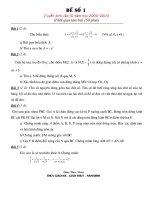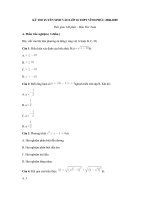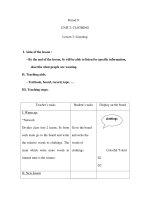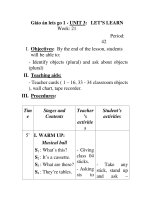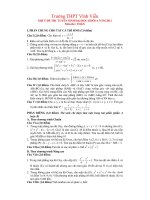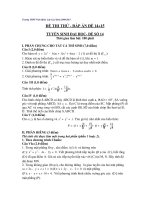- Trang chủ >>
- Sư phạm >>
- Sư phạm sinh
thpt vĩnh trạch dinh tran hoang tuyen period lesson 3 listening i objectives by the end of the lesson students will be able to know more about hoi an ii preparation pictures poster handout books i
Bạn đang xem bản rút gọn của tài liệu. Xem và tải ngay bản đầy đủ của tài liệu tại đây (120.42 KB, 3 trang )
<span class='text_page_counter'>(1)</span><div class='page_container' data-page=1>
THPT Vĩnh Trạch Dinh Tran Hoang Tuyen
Period:
<b>Lesson 3: Listening</b>
<b>I.OBJECTIVES : By the end of the lesson, students will be able to: </b>
know more about Hoi An
<b>II. PREPARATION : Pictures, poster, handout, books…</b>
<b>III.PROCEDUCE: </b>
<b>Time</b> <b><sub>Contents</sub></b> <b><sub>T’s & Ss’ activities</sub></b>
7’
8’
<i><b>I.</b></i> <b>Warmer : </b><i>(Guessing game) </i>
<b> </b><i>Work in pairs. </i><b>Look at the pictures then answer the</b>
<b>following questions. </b>
<i><b>1.</b></i> <i>What are the names of the places?</i>
<i><b>2.</b></i> <i>Which of the places have you been to?</i>
<i><b>3.</b></i> <i>Which one would you like to visit most? Why?</i>
- Notre Dame Cathedral- HCMC
- Ha Long Bay- QN
- The Huc Bridge- Hanoi
- Noon Gate – Hue City
- Assembly Hall of Cantonese Chinese Congregation
- Tan Ky House
- Japanese Covered Bridge
- T introduces the new lesson.
You’re going to listen to a short passage about HOI AN, a very
famous historical place in Vietnam and other well-known places in
the world.
<i><b>II.</b></i> <b>Pre-listening :</b>
<i> </i>Vocabulary
- Merchant (n): nhà buôn
- Vessel = big ship
- Ornamental (a): dung để trang trí
- Pillar (n): cột
- Tile- roofed: lợp bằng ngói
Here are some words that you’re going hear in the listening text.
Now listen and repeat:
<b> Merchant carved vessel heritage</b>
<b> Pillar destination ornamental certified </b>
<i><b>III.</b></i> <b>While-listening :</b>
- T divides the class
into 2 groups to do the
task.
- T gives possible
answers and leads in
the new lesson.
- T sets the scene
<b>- T pre-teaches some </b>
new words
<b>- Ss listen and repeat</b>
- T asks Ss to do the
<b>UNIT 16</b>
</div>
<span class='text_page_counter'>(2)</span><div class='page_container' data-page=2>
THPT Vĩnh Trạch Dinh Tran Hoang Tuyen
20’
10’
<b>Task 1: Listen and choose A, B, C or D that best completes</b>
<b>the sentences. </b>
1. Hoi An is located _____ kilometers south of Da Nang.
A. 13 <b>B. 30</b> C. 16
2. Hoi An used to be an important trading centre _____ .
A. in Southeast Asia
B. in the 19th<sub> century</sub>
C. in the Far east
3. Hoi An is well-known for its old houses which are _____ .
A. small and thatch-roofed
B. narrow and carved
C. small and tile-roofed
4. The Japanese covered Bridge was built _____ .
A. in 1855 B. in the 18th<sub> century C. in the 16</sub><b>th<sub> century</sub></b>
5. Tan Ky House was built as a _____ .
A. house for a Chinese merchant
B. meeting hall for the Cantonese Chinese
C. house for a Vietnamese merchant
<b> Task 2: Listen again and fill in the gaps with the suitable </b>
<b>word</b>
The ancient town of Hoi An lies on the Thu Bon River, 30
km south of Da Nang. It was formerly a major trading centre in
Southeast Asia between the 16th<sub> and 17</sub>th<sub> (1) centuries. Hoi An was</sub>
also an important port for Dutch, Portuguese, Italian, Chinese,
Japanese and other (2) merchant vessels from the Far East.
Hoi An is famous for its temples, (3)pagodas, small
tile-roofed houses and narrow streets. All the houses were made of
wood and their (4) pillars were carved with (5)ornamental designs.
One of the main attractions of Hoi An is the Japanese Covered
Bridge, which was built in the 16th<sub> century and is still </sub>
well-preserved. All visitors to Hoi An are (6) recommended a visit to
the Assembly Hall of Cantonese Chinese Congregation. This
house was built in 1855 and still keeps many precious objects that
belonged to the Chinese community of Hoi An. Another attractive
address to (7) tourists is Tan Ky House, which was constructed
nearly two centuries ago as a house for the Vietnamese merchant.
The house now looks almost (8) exactly as it did in the early 19th
century
<i><b>IV.</b></i> <b>Post-listening : </b>
<b>Task 3: Listen again and answer the following questions. </b>
<i><b>1.</b></i> <i>Where is the ancient town of Hoi An situated?</i>
<i><b>2.</b></i> <i>What was Hoi An known as between the 16th<sub> and the 17</sub>th</i>
<i>centuries?</i>
<i><b>3.</b></i> <i>What is it now famous for?</i>
<i><b>4.</b></i> <i>What are the old houses in Hoi An like?</i>
<i><b>5.</b></i> <i>How old is the Assembly Hall of Cantonese Chinese</i>
<i>Congregation?</i>
<i><b>6.</b></i> <i>When was Tan Ky House built?</i>
<i><b>7.</b></i> <i>What is special about this house?</i>
task individually.
- Then T asks Ss to
compare their answers
with a partner’s.
- T lets Ss listen 1 more
time and check the
answers.
- T gives feedback.
- T runs through the Qs
to make sure Ss can
understand what to do.
- Ss listen alone to do
the task.
- Ss give answers
- T elicits and gives
feedback to Ss.
- Ss work in pairs to
give the answers.
</div>
<span class='text_page_counter'>(3)</span><div class='page_container' data-page=3>
THPT Vĩnh Trạch Dinh Tran Hoang Tuyen
<i><b>8.</b></i> <i>When was Hoi An recognised by UNESCO as a World</i>
<i>Cultural Heritage Site?</i>
<i>Keys:</i>
1. On The Thu Bon River, 30 km south of Da Nang.
2. As a major trading centre in Southeast Asia between the 16th
and 17th<sub> century.</sub>
3. It is famous For its old temples, pagodas, small title-roofed
houses and narrow streets.
4. They were made of wood and their pillars were carved with
ornamental designs.
5. It was built in 1855
6. Nearly 2 centuries ago.
7. The house now looks almost exactly as it did in early 19th<sub> </sub>
century.
8. In 1999.
<i><b>V.</b></i> <b>Homework :</b>
<b> + Write something about Hoi An (about 50 words), using the </b>
following cues.
- Its location and roles in the past.
- Its attractive characteristics at present
- Its main tourist attractions and their features
necessary.
- Some Ss give answer
in front of the class.
</div>
<!--links-->
